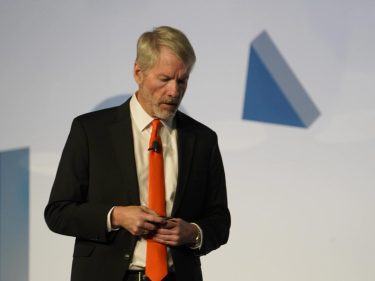Bitcoin Pioneer Hal Finney Posthumously Wins New Award Named for Him
The Human Rights Foundation has announced that computer scientist and privacy advocate Hal Finney, who played a role in getting Bitcoin going 15 years ago, will posthumously be the first recipient of an award named in his honor.
This roundup is part of CoinDesk’s “Future of Bitcoin” package.
Fran Finney, his widow, will accept the inaugural Finney Freedom Prize on Hal’s behalf and plans to donate the monetary prize of 1 bitcoin (BTC) to a yet-unnamed charity. Hal Finney died in 2014 due to complications from amyotrophic lateral sclerosis, or ALS.
HRF Chief Strategy Officer Alex Gladstein said the award is meant to honor those who make vital contributions to Bitcoin.
“Obviously we can’t give it to Satoshi. So, beyond that, it’s Hal. No one even comes close to his contributions,” Gladstein told CoinDesk in an interview. “He coded until his last days. I mean, he literally contributed to human freedom until his muscles didn’t cooperate anymore.”
Read more: Who Is Satoshi Nakamoto?
“Hal would have been thrilled to see how this Bitcoin ecosystem has grown, and to learn that this once-obscure software project is now used by tens of millions of people worldwide,” Fran Finney said in a pre-recorded acceptance speech. “He would be honored to be the first recipient of this award, and humbled to have it be in his name. I feel great privilege and responsibility in accepting the first prize on his behalf.”
The Human Rights Foundation has set aside an additional 32 bitcoin, worth over $2 million at current prices, out of its own treasury to make awards well into the future. “Our view is that in 40 years, it’ll probably be the world’s largest cash prize,” Gladstein said.
For the next three years, the foundation will name a new laureate on Jan. 10, also known as “Running Bitcoin Day,” or the day Hal Finney posted on Twitter (now X) about becoming the first person besides Satoshi Nakamoto to download the Bitcoin software. After that, the awards will be handed out to coincide with Bitcoin halvings, approximately every four years. (The next one happens in a few hours from press time.)
The first four awards, including Finney’s, are meant specifically to retroactively reward those who made the biggest contributions to Bitcoin within the periods between each of the first four halvings: 2009-2012 (Finney), 2012-2016, 2016-2020 and 2020-2024. After that, the prize will go to those who contribute most in the intervening four years.
A “Genesis Committee” of seven individuals – including “The Genesis Book” author Aaron van Wirdum, Africa Bitcoin Conference founder Farida Nabourema, Bitcoin Core dev Gloria Zhao, bitcoin++ and Base58 co-founder Lisa Neigut, Fedi founder Obi Nwosu, Stone Ridge Holdings CEO Ross Stevens and Running Bitcoin Challenge co-founder Vitus Zeller – was picked to lead the nomination process until 2028.
Committee members will then nominate their successor, who will serve a four-year term.
“This is a prize that will outlast us all,” Gladstein said, noting that the last Bitcoin halving will take place sometime in the next century. “Hopefully we can have some kind of intellectual lineage here going through the decades. The first seven are only going to choose somebody who they really feel embodies their ideals so hopefully you get a committee in 100 years that’s somewhat reflective of the initial committee.”
Even if Hal Finney had never discovered Bitcoin on the Cypherpunk Mailing List, becoming the first person to receive a bitcoin transaction and contribute code to the project, it’s likely he would be remembered by the Bitcoin community for his many contributions to cryptography and his privacy advocacy
A graduate of the California Institute of Technology, Finney began to make contributions to foundational cryptographic communications tool Pretty Good Privacy (better known as PGP) in the early 1990s, before working for the PGP Corp. directly until retirement. The program remains one of the best ways to encrypt online communications.
“The work we are doing here, broadly speaking, is dedicated to this goal of making Big Brother obsolete,” he wrote to a group of cryptographers, at a time when the U.S. government was looking to limit the public’s access to strong encryption.
Finney’s work on PGP led to his interest in digital currencies, which he thought could better protect people’s privacy than the emerging payment options like credit cards that were beginning to dominate (and still dominate) the web. In 2004, Finney created a prototype digital asset that reusable proof-of-work system, which although it didn’t catch on, went on to directly inspire Bitcoin.
See also: Bitcoin and the Rise of the Cypherpunks
Four years later, when Satoshi unveiled the Bitcoin white paper, Finney was one of a few people who took notice. He responded on Satoshi’s announcement post on the cryptography mailing list that he looked forward to seeing how the concept would be developed and was offered early access to the project source code.
Between 2009 and 2013, when Finney announced he was paralyzed on the BitcoinTalk forum, he made several key contributions to the Bitcoin software. Throughout his life he was a frequent marathon runner, alongside his wife Fran. In a 2009 Less Wrong blog post, Finney wrote “my dream is to contribute to open source software projects even from within an immobile body.”
There are some who believe that Finney is Satoshi, or a possible contributor to a group that referred to itself under the collective name. A recent post by Bitcoin OG Jameson Lopp disputes this claim, after reviewing timestamps that show Finney was often probably elsewhere while Satoshi was online. Finney himself denied that he was Satoshi Nakamoto.
“We wanted to do the prize not just to honor Hal’s contributions to Bitcoin, but digital privacy and freedom generally,” Gladstein said. “It is something that is very important to us.”




